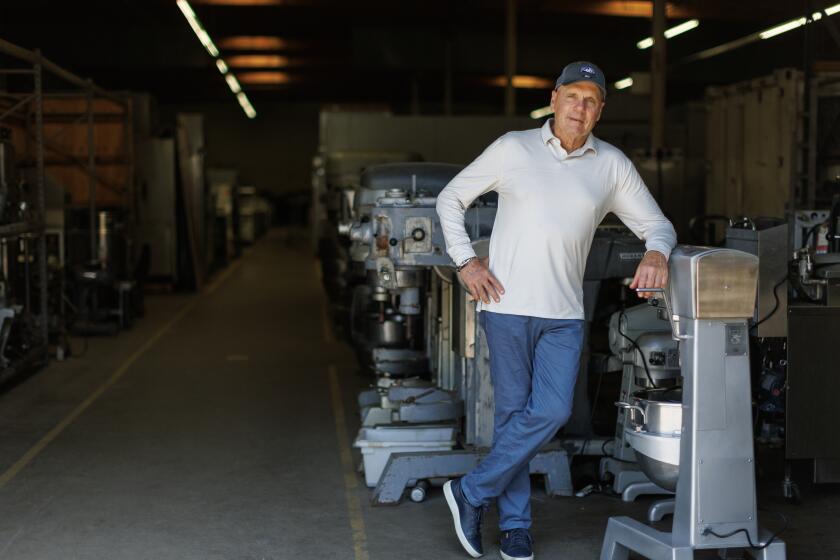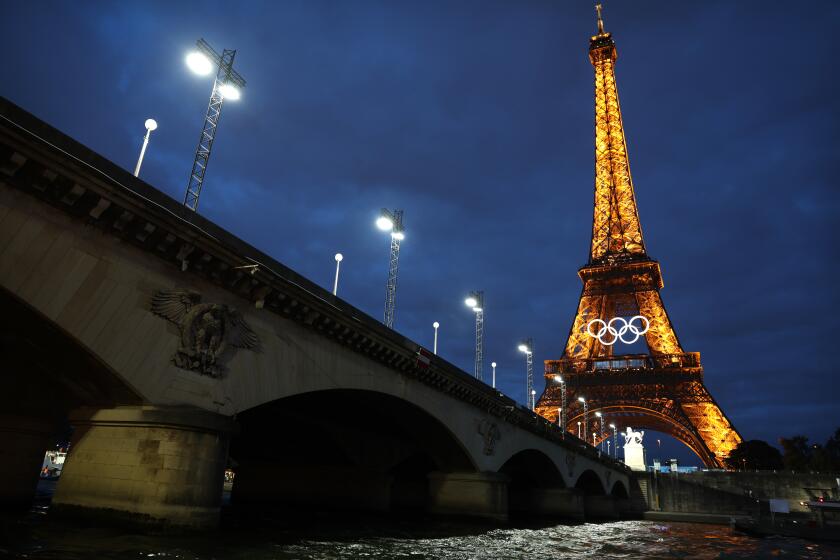Coffee Talk : The Frustrating Mechanics of a Cup of Joe
“In light of all the difficulties of making a good cup of coffee in the 19th Century,” says Ian Bersten, “I really don’t know why coffee-drinking continued.”
Bersten, an ultra-jovial Australian and all-around coffee guy (“If you can put the word coffee in front of it, I’ve done it: roaster, grinder, brewer, shop owner”), has written a huge volume--something between a scholarly study and a, well, coffee-table book--on the history and technology of tea and coffee, entitled “Coffee Floats, Tea Sinks.”
The name sums up the problem. Coffee grounds, buoyed by gases formed in roasting, float when hot water is added, while tea leaves immediately get wet and sink. When you’re making coffee, you have to find some way of getting the water into the grounds so that you can brew the flavor, but before the bitter tannin starts to be extracted.
“People are always saying coffee never tastes as good as it smells,” Bersten points out. “They never say that about tea.”
Unfortunately, the coffee-making inventions that the 19th Century produced so enthusiastically missed the mark most of the time. At that time, the French were at the center of coffee innovation, but their leading thinker, Antoine Alexis Cadet-de-Vaux, believed coffee should be “brewed” with cold water the day before and then heated up. “That would absolutely guarantee a bitter cup,” says Bersten.
And wrong theories were only the beginning of coffee-lovers’ troubles 150 years ago. Bersten ticks off the problems: Roasting equipment was primitive, so coffee must often have had either a flat or a burnt flavor. The coffee itself was likely to be stale (beans were stored in leather pouches sealed with grease) or adulterated with chicory, acorns, figs or used grounds.
Often the beans were physically damaged. Seawater turned them gray outside and green inside, and fresh water turned them white and smelly, so coffee merchants dyed them with rust, indigo or beef blood (caramelized in sulfuric acid), or glazed them with eggs or gelatin. An 1845 Dutch coffee-roasting recipe included cocoa beans, lemon pips, cinnamon and bread to improve the aroma, and added: “If the coffee has been damaged in any way, evidenced by false color, take out the bread and replace with onions. When the coffee is half-roasted, take out the onions, add two cloves and one peppercorn and continue roasting.”
On top of all that, it was impossible to grind coffee properly. “You never read, ‘Use fine grind’ in 19th-Century writings,” says Bersten. “Their grinders didn’t have sharp enough cutting faces. The necessary precision was beyond their technology.” He has scores of antique coffee grinders, and none of them can grind fine, so they would have made coffee that was either weak or bitter or both.
So why did people keep on drinking coffee? “Maybe,” Bersten speculates, “it’s the fact that coffee always smells good when it’s just ground, even when badly roasted. This may have been the only thing that kept coffee-drinking going. It must have set up a Pavlovian conditioning.” In our own time, coffee advertisements have often shown people delighting in the smell that comes out of a can of coffee when it’s first opened, rather than in the aroma of the cup.
Back up there a second. Bersten owns scores of antique coffee grinders? Yes, scores, and hundreds of coffee makers, dating back as far as 1790. “I keep my antiques all over,” he says, “150 in the dining room, 400 under the house, 200 in the garage, crates of stuff in my factory. I’m building a 600-square-foot museum on top of my house in Sydney.”
Hundreds of photographs from this obsessional collection, together with diagrams from various European patent offices, fill his book, providing an oddly impressive view of human ingenuity at its most hopeful, deluded and downright cranky. All the designs were dealing with the same problem: It can take water as long as five minutes to penetrate to the center of the “foam bed” of floating coffee grounds, but the bitter tannin starts being extracted in about 45 seconds.
What can you do about this? You can just pour hot water over the grounds and either accept the bitterness, as with Turkish coffee or cowboy coffee, or try to pour the liquid off the grounds before it gets too bitter. Probably most coffee was made in some such rough-and-ready way in the 19th Century.
Or you can push the spent grounds away from the water, as in the French plunger pot. This makes a good cup, Bersten says, if you make sure to stir the grounds so that they break up and start brewing quickly. (The plunger idea goes back to 1852, but like fine grinding, it was an idea ahead of its time. It wasn’t until this century that we had the technology to make a plunger that actually separated all the grounds from the brew.)
All the other methods involve moving water through the grounds; for instance, letting it drip through a filter. The idea of filtered coffee goes back to the 17th Century, and the world has seen porcelain filters, sock-shaped cloth filters, paper filters and even gold filters. Bersten says that if you pour boiling-hot water into a filter from the height of a foot or so, it conveniently cools down to the 198- to 205-degree range that makes the best coffee, so if you’re careful to stir up the floating grounds so they brew, a filter can make good coffee.
The main problems with the drip method have always been the need to clean the filters all the time (unless they’re disposable) and the inconvenience of having to pour the water onto the grounds. Even 200 years ago, people were already longing for an automatic coffee maker.
So the reversible filter coffee maker was invented. You boiled the water in one compartment, turned the device upside down and let the water drip through the coffee into another compartment. The 19th Century also created the pumping percolator, where the steam pressure of the boiling water forced it up a tube so that it dripped onto a filter full of coffee.
The usual American percolator, a design that was patented in France in 1838, is technically a recirculating pumping percolator. Coffee purists despise it, because the brewed coffee continually returns to the chamber where the water is boiling, thereby losing its aroma into the air. Some people consider the American percolator basically a way of perfuming a house. After all, as Bersten points out, this is the only country in the world that uses the expression, “Wake up and smell the coffee.”
Others dismiss the American percolator as evidence that Americans are suckers for anything that seems technological, but Bersten happens to disagree. In the 19th Century, American authors had traditionally recommended horrifically long brewing times--half an hour or more. “I think the American use of the percolator was a defense against bitter coffee,” he says. “It uses a coarse grind, so there’s less extraction of tannin.” If the aroma mostly went into the air, well, it mostly went into the air with a lot of other 19th-Century coffee-brewing methods too.
The American love affair with the percolator continues, of course. “There’s a wider range of coffee quality in the U.S. than any other country,” says Bersten. “In most countries, there’s a basic standard of quality around which all coffee revolves. But here you have both percolated lunch counter swill and exquisite espresso coffees.”
Drip and percolator methods make relatively watery coffee. To make a stronger cup, the key is to force the water through the grounds. Then there can be a fair race between the brewing of flavor and the extraction of bitterness.
The earliest method, says Bersten, was the vacuum pot, first mentioned in 1827. For this, the hot water is forced up onto the coffee by steam pressure, then the heat source is removed and the condensing steam creates a partial vacuum, which sucks the water back through the grounds.
The next method was the earliest sort of espresso, known as the “long” espresso (because it takes two minutes or longer to brew a cup), which is still used in stove-top espresso devices such as the Bialetti Moka. Here the boiling water is forced through the grounds by steam pressure from the boiling chamber--direct steam pressure, rather than a vacuum. An 1837 design, invented by a French optician named Lebrun, was still being manufactured in the early 20th Century. You poured alcohol around the rim and lit it, and the heat drove the water through the coffee and out a little curved pipe. “It wasn’t what we’d call espresso today,” Bersten says. “It would have produced something a little stronger than filtered coffee.”
The trouble with both vacuum and steam espresso methods is that the coffee grounds have to be tamped fairly tight into some sort of filter box or the water merely passes around them, rather than penetrating them. But coffee grounds swell up when they are wetted, and the 19th-Century machines were nowhere near as sturdy as the brewing basket of a modern espresso maker.
“There was a high risk of explosion in all these models unless they had safety valves,” says Bersten, “and a lot of them didn’t. They could have been table-top grenades. Some patents point out that their design ‘represents a distinct advance because it won’t explode.’ ”
It’s at this stage of coffee-maker evolution that the most gloriously absurd machines were invented. There were Loysel’s gas-heated machines, which combined espresso and vacuum principles--they pushed the water up through the grounds into a pot above, then sucked the brewed coffee back through the grounds by vacuum. Loysel’s 8-foot-tall machine was the hit of the 1855 Paris Exposition. He eventually built one 11 feet high, the tallest coffee maker ever.
In 1872, a woman named Eriberta Predari invented a vacuum pot that boiled an egg while it made coffee. Other inventors hid pumping percolators in tabletop brewers that looked like toy locomotive engines. One of the most efficient 19th-Century machines, says Bersten, was Eicke’s 1878 model: An alcohol flame boiled the water, driving it into a coffee brewing apparatus on the other end of a balancing arm. When the coffee was brewed, it overweighed the boiler, which tipped up, releasing a lid that snuffed out the flame. Voila ! An automatic coffee maker! (In 1895, a man named Hertmann perfected this idea by setting up a clock to strike a match and light the alcohol burner at a predetermined hour--the first real wake-up-and-smell-the-coffee machine.)
It wasn’t until after World War II that the final development in coffee brewing was perfected, the true or short espresso (so called because it brews in a shorter time than the long espresso). In this method the water is forced through the grounds by mechanical force, such as an electric pump, rather than by steam. At last, water could be forced through the coffee grounds in 30 seconds, safely before tannin extraction.
And not only that. Freed from their dependence on steam, coffee makers could experiment to discover the perfect water temperature (198-205 degrees) and the perfect pressure (nine atmospheres) for brewing.
The result is a kind of coffee that had never existed before. Because of the high water pressure used in making true espresso, says Bersten, about 10% of the oils in the grounds become emulsified, and the aromas attach themselves to the oils. So espresso is more fragrant than other coffees, and has more body and roundness in the mouth. The crema or layer of foam on top of an espresso, by the way, consists of very tiny bubbles of carbon dioxide forced out of the grounds by water pressure, and it retards the evaporation of the coffee aroma.
In Bersten’s opinion, we are now living in a golden age of coffee: “In the 15th Century and for a long time afterward, people referred to coffee as a bitter beverage. Today there are 200 ways of making good coffee.”
But he has nowhere near as sanguine a view of the coffee trade. “The coffee business has made an art form of raising barriers against information,” he says. “Roasters try to keep you out. And they don’t really understand what they’re doing themselves.”
His own first experience with this came when he was exploring the idea of opening an espresso shop in Australia 25 years ago: “When I asked a coffee seller for raw coffee beans, he pushed me down the stairs.” To Bersten, who was trained as an economist, it was obvious that the markup on roasted beans had to be lucrative. He decided that day to go into the coffee-roasting business. Collecting information on coffee-making science, and coffee antiques, followed quickly.
And an all-around irreverent attitude toward coffee commonplaces. The decaf craze, for instance. “Coffee is everybody’s whipping boy,” he says. “Nobody says anything about the caffeine in tea or aspirin or cocoa--and we think cocoa is a drink to give children.”
Bersten does like tea, though, and his book has photographs of about 70 teapots. The contrast with coffee makers is remarkable. Coffee equipment tends to look like industrial machinery, while teapots often have cozy, whimsical designs.
Well, of course--tea sinks. There’s been no need for technological advance in tea brewing for thousands of years. “Tea is so easy to make,” he says, “it has no mystery. That may be why teapots often have fanciful shapes. You never find a coffeepot with a face painted on it.”
*
You can order “Coffee Floats, Tea Sinks: Through History and Technology to a Complete Understanding,” by Ian Bersten (Helian Books, Sydney: 1993; 262 pp., $90) by calling (800) 365-BEAN.
More to Read
Eat your way across L.A.
Get our weekly Tasting Notes newsletter for reviews, news and more.
You may occasionally receive promotional content from the Los Angeles Times.






